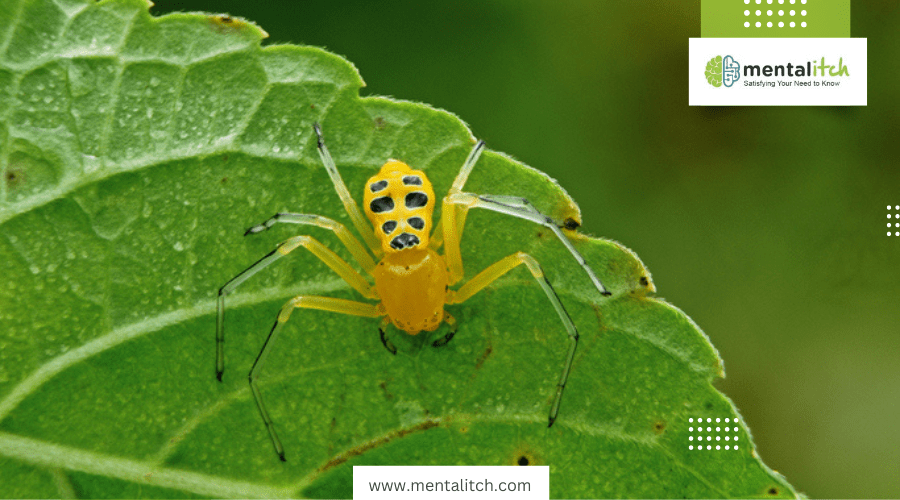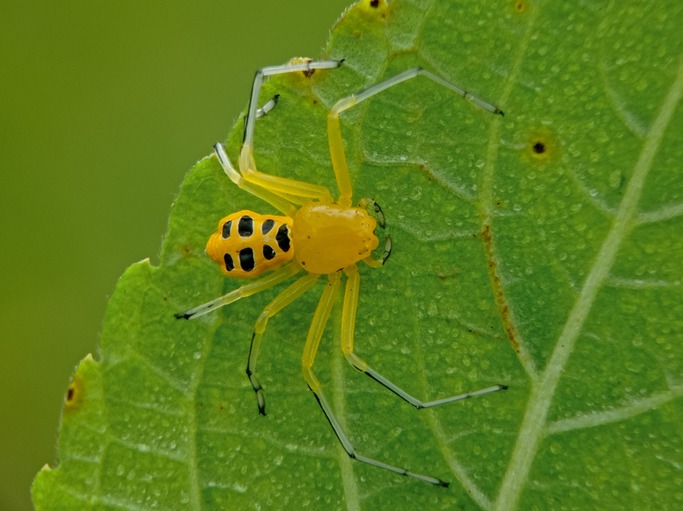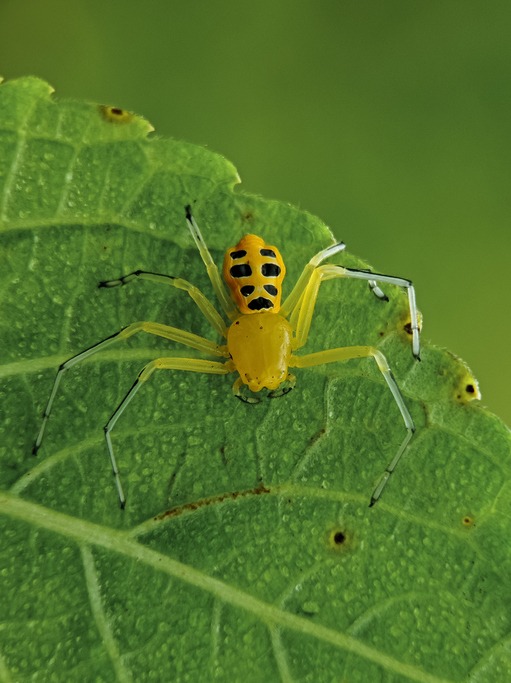The crafty eight-spotted crab spider capitalizes on its coloration to cunningly catch its prey and cleverly conceal itself from predators. As you explore the spider’s world, you’ll find that its ability to change hues to harmonize with the flowers it frequents is not just about survival; it’s an intricate dance of deception and defense. This remarkable adaptation allows it to ambush unsuspecting insects and evade those who might wish it harm. But how exactly does this mechanism work, and what does it tell us about the evolutionary journey of this fascinating arachnid?
Unraveling this mystery offers insights into the complex interplay between predators and prey in nature.
Unique Color Patterns
The eight-spotted crab spider’s unique color patterns, featuring eight distinctive spots, enable it to masterfully camouflage against its surroundings. Unlike other species of crab spiders, this one has evolved a remarkable ability to change its color, blending seamlessly with a variety of backgrounds. This adaptive trait isn’t just for show; it’s a critical survival mechanism that allows these spiders to ambush their prey with deadly efficiency.
When you’re observing these spiders, you’ll notice how their color adaptation isn’t random. Instead, it’s a strategic choice, often matching the hues of flowers like goldenrod and milkweed where they lie in wait. This choice of camouflage is no accident; the flowers serve as perfect hunting grounds, attracting unsuspecting insects right into the spider’s grasp. The spider’s ability to change color and mimic the look of the flowers it rests upon makes it almost invisible to both its prey and potential predators.
This unique coloration isn’t just about hiding, though. It enhances the spider’s predatory success, making it a formidable hunter. By blending into their floral habitats, these spiders can remain undetected until the perfect moment to strike, ensuring their survival and continued dominance in their ecosystem.
Camouflage Strategies
Building on its unique color patterns, the Eight-Spotted Crab Spider employs sophisticated camouflage strategies that are key to its hunting success. By utilizing its color-changing ability, it blends seamlessly with the environment, making it nearly invisible to both its prey and predators. This spider’s mastery of camouflage is not just about hiding; it’s an active strategy for ambush. As you watch closely, you’ll notice how it adjusts its hues to match the flower petals it rests upon. This isn’t just for show. It’s a deliberate tactic to remain undetected by unsuspecting prey that venture too close.
The efficiency of this approach cannot be understated. By adapting its color to its surroundings, the spider ensures it remains unseen until the perfect moment to strike. This not only increases its hunting success but also plays a critical role in its survival. Predators often overlook the spider, mistaking it for part of the floral backdrop. In the grand scheme of things, the Eight-Spotted Crab Spider’s ability to camouflage is fundamental to its predatory behavior and overall survival in its habitat. This ingenious use of color-changing for camouflage and ambush underlines the spider’s remarkable adaptation to its environment.
Mimicry Techniques
Expanding its arsenal of deceptive strategies, the eight-spotted crab spider also excels in mimicry techniques, cleverly resembling ants to catch its prey off guard. This spider’s coloration is the key to its aggressive mimicry, allowing it to blend in with ant colonies and ambush unsuspecting insects. By mimicking ants, not only does it camouflage itself perfectly among them, but it also lures in prey that would not typically fear an ant. This strategy considerably broadens the spider’s menu, giving it access to a wider range of insect species for food.
Here’s how the spider’s mimicry techniques benefit its survival:
- Deceptive Camouflage: Merging seamlessly with ant colonies to avoid detection by both prey and predators.
- Increased Prey Variety: By resembling ants, it attracts insects that usually do not consider ants as threats.
- Strategic Advantage: The coloration and mimicry provide a strategic advantage in ambushing prey.
- Enhanced Hunting Success: Mimicry leads to closer approaches by the prey, making the attack more successful.
Through these mimicry techniques, the spider’s coloration plays a critical role in its survival, enabling it to capture prey effectively and maintain its place in the ecosystem.
Prey Attraction
Shifting focus to how the Eight-Spotted Crab Spider lures its meals, its coloration plays a pivotal role in attracting prey such as bees and flies by blending into the floral backgrounds they frequent. This species has mastered the art of camouflage, adopting hues of yellow and white that mimic the very flowers it inhabits. By perfectly matching these colors, the spider becomes nearly invisible to its target insects, greatly increasing its chances of a successful ambush.
You’ll find that females, particularly, excel in this strategy. Their larger size allows them to take up residence in a wider variety of flowers, giving them access to more abundant prey. Despite their ability to build webs, these spiders often rely more on their coloration and the strategic placement of their legs to capture prey directly from the flower’s surface. This method of prey capture is not only efficient but also conserves energy, allowing the spider to remain stationary for long periods while waiting for an unsuspecting insect to venture too close.
Essentially, the Eight-Spotted Crab Spider’s coloration is a key tool in its hunting arsenal, enabling it to blend seamlessly with its environment and ambush prey with lethal precision.
Predator Avoidance
Through its mastery of color adaptation, the Eight-Spotted Crab Spider skillfully evades predators by blending seamlessly into its surroundings. Its unique ability to match the color of the environment, especially flowers, plays an important role in its survival. By being virtually unseen, it dodges potential threats, leveraging its camouflage to stay one step ahead of predators.
Here’s how the Eight-Spotted Crab Spider’s coloration contributes to its predator avoidance:
- Adaptive Coloration: It changes color to match its surroundings, making it difficult for predators to spot.
- Strategic Camouflage: By blending in with flowers, it reduces the risk of detection and attack.
- Enhanced Survival Chances: Remaining unseen is important for its survival, as it avoids becoming easy prey.
- Protection: Its coloration serves as a natural shield against larger threats, allowing it to live another day.
Communicating Danger
While the Eight-Spotted Crab Spider’s ability to blend into its environment aids in dodging predators, its vibrant coloration also plays a key role in signaling danger to those same threats and its prey. Its bright hues serve as a warning, deterring potential predators and alerting prey to the imminent threat it poses. This strategic use of coloration not only helps in avoiding confrontations with larger predators but also enhances its chances of survival and successful hunting.
The spider shows a remarkable ability to change color to match its surroundings, particularly when situated on white flowers or amidst yellow pigments. This adaptability allows it to select the best hunting site, where its warning colors are most effective.
Here’s a quick look at how the Eight-Spotted Crab Spider communicates danger:
| Aspect | Function | Detail |
|---|---|---|
| Coloration | Warning signal | Deters predators, alerts prey |
| Environment Matching | Avoids confrontation | Blends with flower heads |
| Yellow Pigments | Enhances visual cue | Used on specific hunting sites |
| White Flowers | Hunting site selection | Color to match for effectiveness |
| Visual Cue | Communication of danger | Signals to ecosystem’s inhabitants |
Seasonal Color Changes
The eight-spotted crab spider’s ability to shift from white to yellow with the seasons greatly enhances its hunting success and survival. This seasonal color change is a fascinating adaptation of Misumena vatia, ensuring they remain masters of disguise all year round. Unlike a quick wardrobe change, this transformation is a slow, deliberate morphological process, taking several days to complete. It’s not just for show; this color shift markedly boosts their ability to capture prey, as blending seamlessly into their environment makes them nearly invisible to unsuspecting victims.
Here are a few key points about the seasonal color changes in crab spiders:
- Seasonal Adaptation: Misumena vatia exhibits remarkable seasonal color changes from white to yellow, aligning with their surroundings.
- Prey Capture Success: Shifting body color to match the background increases their chances of a successful catch.
- Pigment Molecules: The color change involves complex biochemical processes, including the synthesis, deposition, and degradation of pigment molecules.
- Background Color Matching: A staggering 96% of female crab spiders manage to match their background color, showcasing the effectiveness of this camouflage strategy.
Understanding these seasonal color changes highlights the intricate balance between crab spiders and their environment, ensuring their survival through cunning disguise and strategic hunting techniques.
Mating Signals
Shifting focus to mating behaviors, male eight-spotted crab spiders rely on their coloration to signal potential mates, highlighting the pivotal role of color in their lives. When you’re a male spider, your colors aren’t just for show; they’re a vital part of how you find a partner. Through vibrant hues and patterns, male spiders broadcast a mating signal that’s hard for females to ignore. These color signals are more than mere decoration; they’re integral to courtship behaviors, playing a leading role in the spider’s mating dance.
Females pick up on these color cues, interpreting them as indicators of a male’s age, health, or genetic quality. It’s nature’s way of ensuring that the best genes get passed on. The brighter and more distinct a male’s coloration, the more likely he is to catch the eye of a discerning female. This color-based communication is key to successful reproduction and the continuation of the species.
Conclusion
So, you’ve seen how the eight-spotted crab spider uses its coloration to thrive. By blending into their surroundings, they become nearly invisible to both prey and predators. Their unique patterns and seasonal color changes aren’t just for show; they’re essential for catching food, staying safe, and even finding a mate. Whether it’s mimicking flowers to attract prey or signaling danger, these spiders have mastered the art of visual communication. It’s a fascinating glimpse into the adaptive powers of nature.


